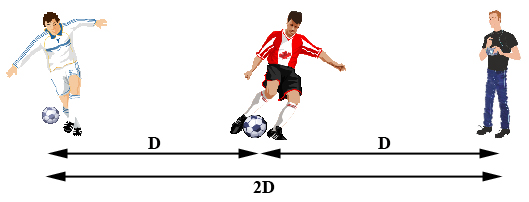The distance from which an object is photographed, and the choice of lens, determine to a large extent the perspective distortion captured within an image. These two factors, taken together, define a camera's angle of view of the subject. Perspective distortion is usually most apparent when a subject is photographed using a wide-angle lens. Objects closer to the camera tend to look larger than a viewer expects, and those further away may appear diminished. This phenomenon is generally known as image extension. With a lens of long focal length, an apparent compression of distances my be perceived but the effect is often less obvious. Objects situated a long distance from the camera may appear too large, and distances between objects at various distances are apparently reduced. This latter effect is usually know as image compression or foreshortening. These impressions, to which photographers often refer as "distortion", are arguably deceptive or even entirely false.
There is, however, another major factor which is commonly overlooked by photographers. This is the distance from which an image is viewed. The normal viewing distance for an image is approximately equal to the length of the diagonal of the image. This is because the focal length for a standard or normal lens is designed to be about the same as the length of the diagonal of the image formed. (For a 35mm camera, the length of the diagonal of the image is in the region of 43mm, so a lens having a focal length of 40mm to 50mm is regarded as standard.) Lenses of this specification produce a perception of normal perspective as seen by human beings. However if the angle of view of the subject at the time of capture is significantly larger or smaller than that observed when viewing the image from this normal viewing distance, some evidence of perspective distortion will be apparent.
When an image exhibiting so-called wide-angle distortion is viewed from a distance closer than the normal viewing distance, the angle of view presented to the viewer becomes larger. This significantly reduces the perception of distortion and, when viewed at one particular distance, the effect may disappear altogether. Similarly, when an image appears to foreshorten distances the impression may be reduced or eliminated by viewing it from a larger distance. 
In the diagram on the right, the footballer in the red shirt is a distance D from both the footballer in the white shirt and the photographer. For the photographer, the two sportsmen are at distances of 2D and D, a ratio of 2:1. If the photographer now moves to within a distance of 0.5D from the player in the red shirt, the respective distances change to 0.5D and 1.5D, a ratio or relative distance of 3:1. The red player will not only appear significantly larger but will have increased in apparent size faster than the white player.
If the photographer takes a photograph incorporating both players from his original position (at a distance D from the red player as shown in the diagram), using a telephoto lens, both men will appear larger and therefore closer in a proportional manner because all the photographer has done is magnify the image. Let us assume that the red player now appears to be a distance 0.5D from the camera, the equivalent of the photographer's second position in the paragraph above. However, the relative distances of the two players from the camera remain unchanged at 2:1. Remember that when the photographer actually stood at the 0.5D position, the relative distance of the two players was 3:1 (because the red player appeared to get larger faster than the white player as the photographer approached). Therefore the image taken using the telephoto lens shows a degree of apparent foreshortening. This is known as perspective distortion. When a wide-angle lens is used, the effect is essentially the same but works the other way around. Seen though the lens, objects look further away but their relative distances remain unchanged. Perspective appears to be exaggerated. This is also known as perspective distortion.
The principle explained above are of course also applicable when a single large object is photographed. The object's nearer and more distant extremities may consequently reveal perspective distortion when photographed using a telephoto lens or a wide-angle lens. Since perspective distortion is apparent in only one plane, the result is that the object may appear to change shape. However when images taken with wide-angle or telephoto lenses are viewed from critical distances respectively smaller or greater than the length of the diagonal of the image, perspective distortion effectively disappears.
Having examined the underlying causes of apparent perspective distortion, we can now address the matter of reality. Are the images taken using wide-angle or telephoto lenses distorted as so many photographers claim, or do they just represent reality? It seems from the paragraphs above that the problem lies with the photographer's presentation of an image and the viewer's lack of understanding of how it should be viewed.
Perceived perspective distortion can be reduced by keeping subjects at a reasonably large distance from the camera. The effect is still present, but its extent is reduced. However, the effect can also be used to good aesthetic effect. For instance, when using a wide-angle lens an object may be positioned close to the lens to emphasize its significance in an image, remove it spatially from other picture elements, or perhaps bring about apparent changes to its shape. With a telephoto lens, apparent compression of distances is commonly used to create or emphasize a feeling of congestion. Just choose whichever reality you prefer!






